Anthurium warocqueanum, a stunning tropical plant with long dark green leaves, is one of the most desirable plants by beginners and advanced houseplant enthusiasts. And for a good reason. No plant can bring quite a jungle vibe like anthurium warocqueanum.
Commonly known as the Queen anthurium, it lives up to its name. Compared to other plants, queen anthurium warocqueanum is a diva that beginner plant parents often fear. It is high maintenance, notoriously finicky, and can seemingly die for no reason.
But fear not. This blog will help you demystify anthurium warocqueanum care. We’ll focus on critical aspects of the queen anthurium care so you can grow this amazing anthurium successfully.
I’ll share what you don’t typically find on other blogs, and for fun, we’ll rank some of the coolest-looking anthurium waroqueanum hybrids.
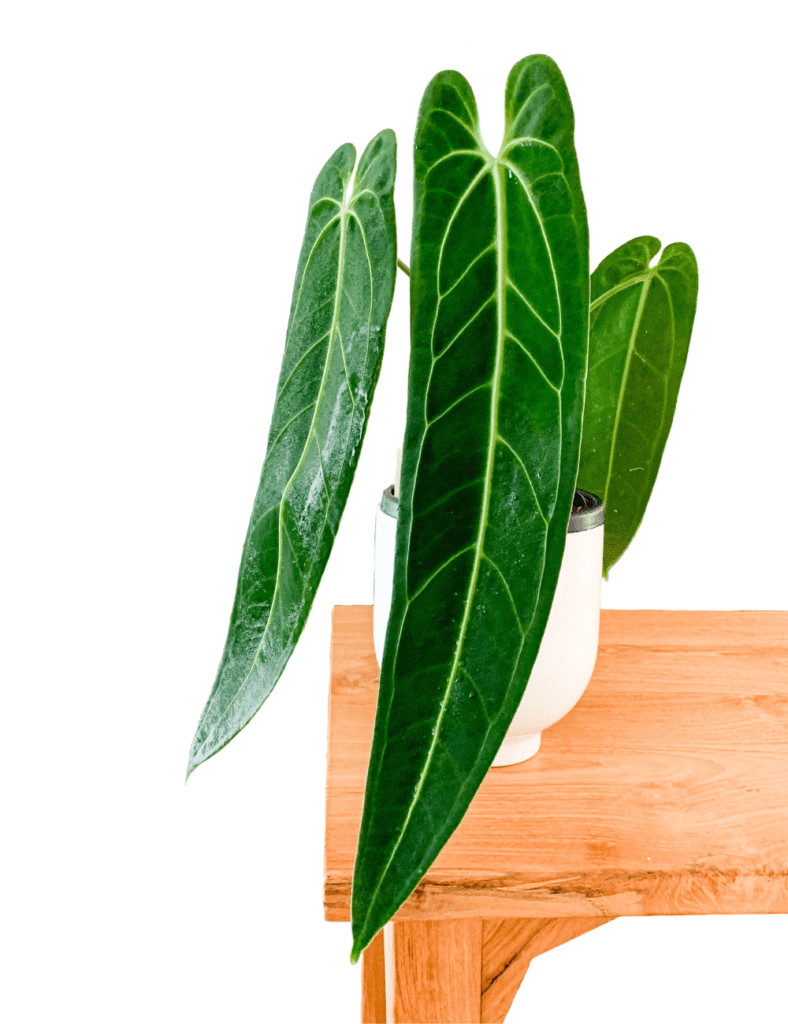
ABOUT QUEEN ANTHURIUM
Anthurium warocqueanum or “warocq” is a tropical plant in the Araceae family native to the rainforests of Colombia. It is an epiphytic plant that grows in wet lowlands and mountain valleys.
The queen anthurium warocqueanum is grown for its magnificent foliage that can reach impressive sizes. In optimal conditions, its velvety leaves can grow over 1 m in length (4-6 feet) when the plant reaches maturity.
The leaves range from dark green to lighter green, and the veins can be more or less pronounced. The silvery white veins usually get more pronounced as the plant matures.
A healthy and well-established plant can support 6-8 leaves simultaneously. I’ve yet to reach that level with my Anthurium warocqueanum. I can hold on to max four leaves. It is a rare tropical plant in the sense that it can be challenging to acquire.
It also comes with a hefty price tag. This anthurium belongs to the Cardiolonchium section, which is important to keep in mind if you’re ever planning to propagate or hybridize the queen anthurium.
Due to its relatively high initial maintenance, I would not recommend this plant for beginners unless you want your heart broken when it dies on you. I only got mine after I tried growing other anthurium species, such as Anthurium crystallinum, Anthurium forgetii, or Anthurium magnificum, and even then, I had some losses.
If you’re into long narrow leaves, try some strap leaf anthuriums first; I find them the easiest to grow. But before we talk about Anthurium warocqueanum care, we should first discuss the process of acclimatizing the anthurium warocqueanum plant to your growing conditions.
Because what others don’t tell you about this plant species is that it is a very easy and fast grower once it acclimatizes to your specific conditions. Once you pass the acclimatization stage, you’re in for a spectacular show.
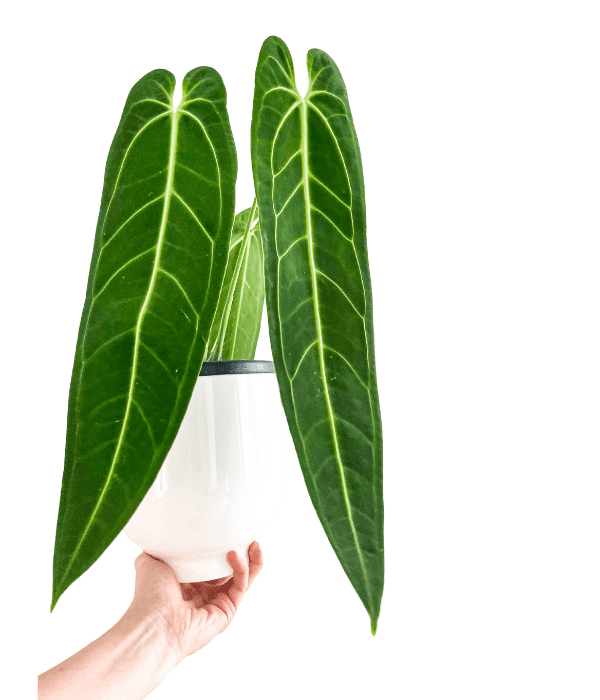
How to Acclimatize Anthurium Warocqueanum
Acquiring a queen anthurium locally will give you the best chance for success. Imported ones from abroad can be difficult to acclimatize and require much more initial effort than if they were grown in your area’s conditions.
I made that mistake and bought one that was shipped to me internationally. Needless to say that the queen did not make it. And this is not to say that your queen will surely die if you order and ship it from abroad. It’s just that the task is much harder.
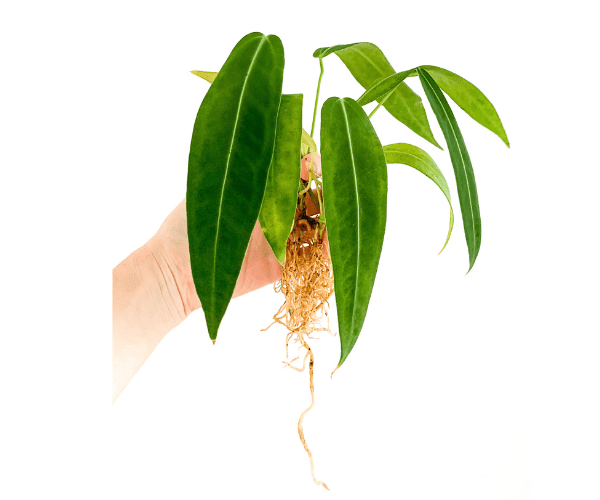
3 POINTS TO CONSIDER WHEN ACCLIMATIZING ANTHURIUM WAROCQUEANUM
1. Where was it imported from?
If your plant comes from a tropical environment like South America or Florida (if you’re in the US), it naturally was grown in much higher humidity than your indoor conditions. So I’d increase the humidity at the beginning to help the plant stabilize. Some cover the imported plants with a plastic bag to keep the humidity high and prevent moisture loss.
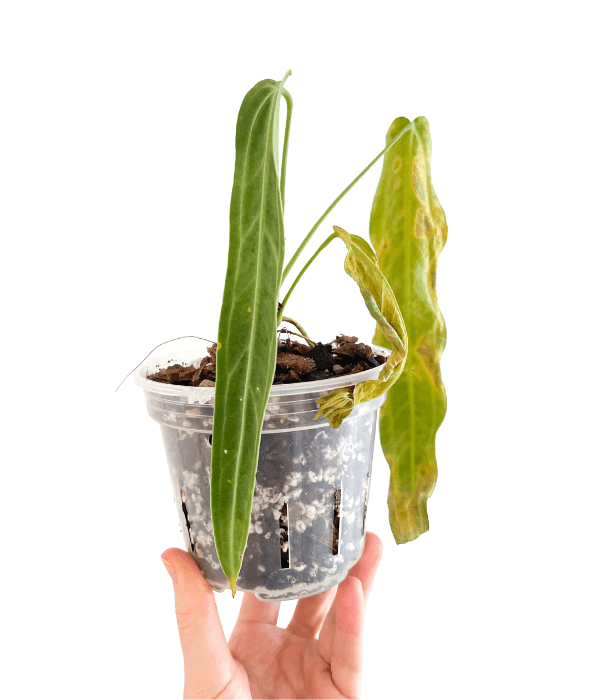
2. How was it shipped, and how long was it in transit?
If it was shipped bare root, which is the case in many situations, then it is most likely severely dehydrated. And likely, it was in transit for several days with no light and airflow. The plant is very much in shock.
Put it in water or damp sphagnum moss, and place it in a grow tent or greenhouse cabinet if you have one. At least try to create a warm and humid environment before slowly acclimatizing to the conditions in which it will grow for good.
3. What time of the year are you importing your queen anthurium?
If you live in a country with seasons, I’d definitely avoid winter. You’ll be adding another layer of complexity trying to acclimatize the queen to your environment in the middle of winter.
Plus, shipping plants in freezing conditions can stress them to the point of no return.
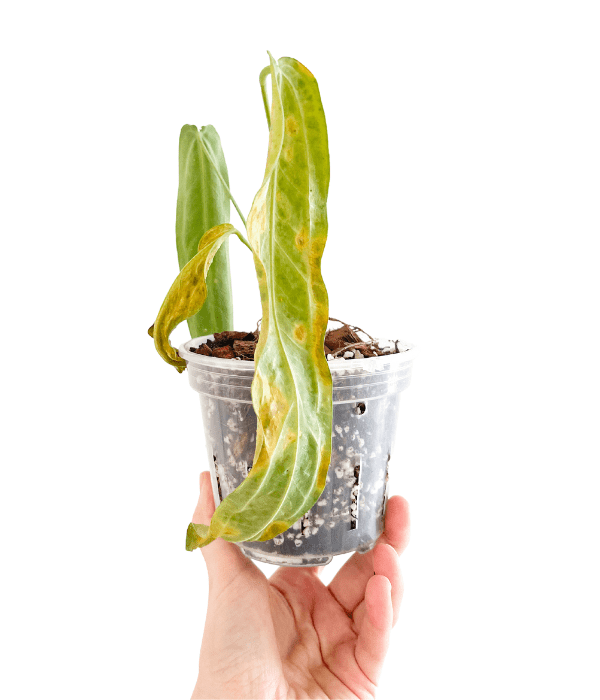
Some anthurium plants handle stress better. But not Anthurium warocqueanum. It is called Queen Anthurium for a reason. She can get quite dramatic.
You should assume your queen anthurium will lose most of its leaves upon arrival. If you have a decent size plant, it should recover and push out new growth already acclimatized to your conditions.
But sometimes she will not recover, and you should also be prepared for that.
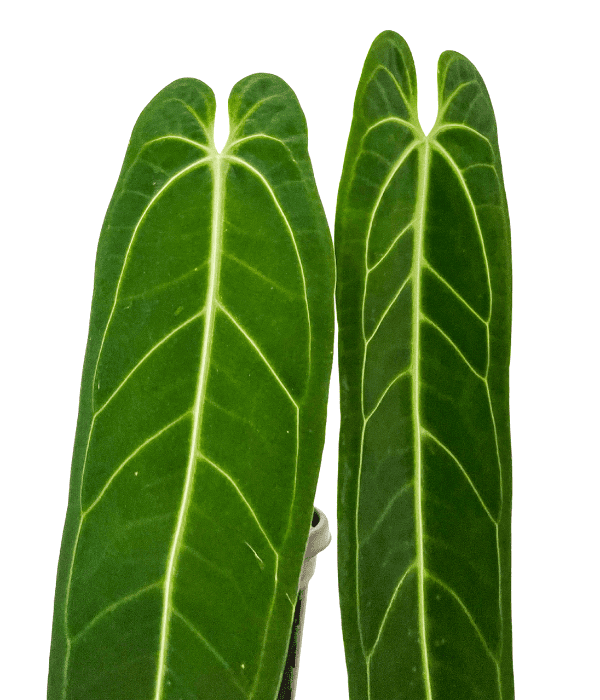
HOW TO CARE FOR ANTHURIUM WAROCQUEANUM
Many houseplant enthusiasts wonder whether the queen anthurium can be grown in indoor house conditions. And I’m here to tell you, absolutely yes!
While many hobbyists use grow tents or IKEA greenhouse cabinets to grow their anthurium warocqueanums, I grow mine on a shelf under grow lights in my living room conditions.
The key is to acclimatize your queen anthurium to your specific conditions. After that, growing the queen will be a breeze.
POTTING MEDIUM
Where anthurium warocqueanum grows in nature will give clues as to what potting mix you should provide.
Like other epiphytes, such as strap leaf anthuriums, it gets all its moisture from rainfall but never sits in the water. Based on that, you know that queen anthurium will thrive in a chunky, well-draining mix that provides a lot of aeration to its roots.
There are many types of growing media aroid enthusiasts swear by, so I will list the most popular of them below. I only tried growing Anthurium warocqueanum in aroid mix and moss.
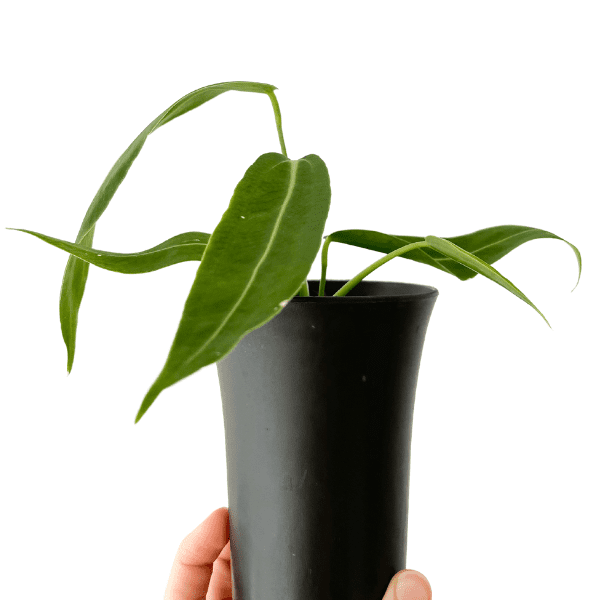
AROID MIX
Most of my anthuriums grow in an aroid mix, and the queen anthurium is no exception. Based on the species, I may adjust the ratio of the various elements slightly.
For my anthurium warocqueanum aroid mix, I use a combination of orchid bark, charcoal, coarse perlite, coco chips, a bit of coco coir, and some worm castings.
The queen anthurium will throw a fit if you pot it up in a very dense soil or potting mix. What you need to remember with a very airy potting mix is how frequently you’ll have to water your plant indoors.
My queen anthurium and strap leaf anthuriums are watered more often than my other anthuriums as the potting mix is not as water retentive and dries out faster. An airy, chunky mix will vastly reduce the incidence of root rot.
Find out if and when you need to repot your queen anthurium in my guide to repotting anthuriums.
SPHAGNUM MOSS
The queen anthurium warocqueanum loves moss! If you grow it in sphagnum moss, it will grow roots quickly.
The problem with growing queen anthurium in sphagnum moss is that you’ll have to water it more frequently and remember to fertilize it often, as moss doesn’t provide any nutrients.
Many add perlite to moss to prevent it from compacting and for extra aeration.
Also, as the plant matures and becomes top-heavy it might be difficult to stabilize it in moss. I like to add a layer of sphagnum moss on top of the aroid mix. My queens seem to love it.
LECA
Leca, or lightweight expanded clay aggregate, is another substitute for soil that many houseplant enthusiasts use. While I’ve seen queen anthuriums grow in leca only, most of the times, leca or perlite only substrates are used for rooting or propagation. It provides excellent aeration, which is essential to prevent root rot.
LECHUZA PON
Lechuza pon consists of high-quality, mineral stones free from contamination and pollutants. It is used for semi-hydro growing, and many swear by it. I haven’t grown any anthuriums in it yet, but I will experiment at some point.
HUMIDITY
Is low humidity the real reason why your queen is dying?
Humidity, humidity, humidity is all you seem to hear when it comes to Anthurium warocqueanum care. Naturally, Anthurium warocqueanum grows in tropical conditions where humidity is very high, and these tropical plants love high humidity! But does humidity level really play such a huge role?
Let’s be honest, unless you grow your queen anthurium in a grow tent or greenhouse cabinet with 80%-90% humidity levels, you won’t be able to replicate such high humidity in your living room, where it can go way below 50%, depending on the season and where you live.
Having said that, you can successfully grow the queen anthurium in average humidity if you first acclimatize it properly. And then adjust your watering accordingly. In lower humidity levels, your queen anthurium will transpire faster, so you’ll have to water it more frequently.
How vital is airflow for anthurium warocqueanum?
Airflow and humidity are closely interlinked and are essential to anthurium warocqueanum care. Whether you’re growing your queen in an enclosed cabinet, grow tent, or in your living room, adequate air circulation is critical to the well-being of your queen anthurium.
In their natural habitat, they live in high humidity and constant airflow. In your living room, make sure you put her in a space that has proper air circulation. In an enclosed cabinet, installing a fan is a must, or you’ll risk bacterial and fungal infections.
Should you get a humidifier for your queen anthurium?
If your indoor humidity is below 50%, invest in a humidifier. But if your humidity is 50% and above, you can go without it. If you decide to get the humidifier, all plants will thank you for it, not just the queen!
You’d want to place it near the Anthurium warocqueanum so it enjoys the higher humidity; just make sure the leaves don’t get wet, as it can create bacterial and fungal issues.
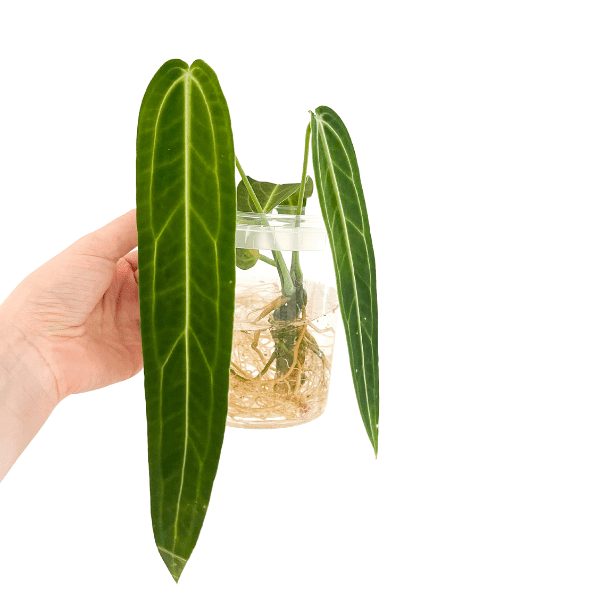
LIGHT
In nature, they grow under the canopy of tropical rainforests, and if grown outdoors, they like partial shade. But that doesn’t mean you should put the queen in a dark corner of your home.
A shady outdoor place will still be brighter than your indoor space, so give her ample light. I keep mine under grow lights. Bright indirect light but no direct sunlight is perfect for them.
Read my guide on light requirements for anthuriums and the secret to make the leaves darker!
WATERING
I find anthurium warocqueanum quite thirsty. It definitely drinks water faster than my other anthuriums. Read my guide on watering anthuriums here.
TEMPERATURE
Anthurium warocqueanum plants will not tolerate very high temperatures (above 100F), but if you’re growing them indoors, the temperature will hardly ever be an issue. They can tolerate lower temperatures than most anthurium plants, but warm temperatures are the optimal environment for these tropical plants.
FERTILIZER
Based on my observations from growing various anthuriums, anthuriums in general, are heavy feeders. In nature, they get their nutrients from leaf litter and other organic matter that falls on their exposed roots.
And while some argue that epiphytic plants don’t require much fertilizing, in my limited experience growing epiphytes such as Anthurium vittarifolium, they respond very well to fertilizers by pushing new growth much faster.
I provide my queen with slow-release fertilizer every three months and diluted liquid fertilizer with every watering.
Anthurium Warocqueanum Forms – Is There Such a Thing?
Anthurium warocqueanum green vs. narrow dark form
If you searched online for the queen anthurium, you’d notice that it’s often referred to as anthurium warocqueanum regular, green form, narrow form, or dark form, sometimes referred to as “black warocq.” Now, is there such a thing?
Based on my research, there is only one form of anthurium warocqueanum. And the differences in how they look from plant to plant are attributed to natural variation.
The queen anthurium, like most anthuriums, is a highly variable species, meaning that the plants can vary significantly in how they look within the same species.
Many variables can affect this, from growing conditions to the plant’s genetic makeup.
Some warocqs you’ll see with green leaves, some with very narrow leaves, and some with very dark, almost black leaves with very prominent silver veins.
Collectors often acquire multiple plants in the same species that exhibit different characteristics. That’s one of the reasons why this hobby is so much fun.
Is there a variegated form of Anthurium warocqueanum?
Variegated plants are all the hype these days, but sadly Anthurium warocqueanum doesn’t have a variegated form. I have never seen one and never heard of anyone having it.
It would be a unicorn plant if it existed, rarer than Philodendron Spiritus Sancti! (Although they are in tissue culture already, we should see them at more affordable prices in the near future).
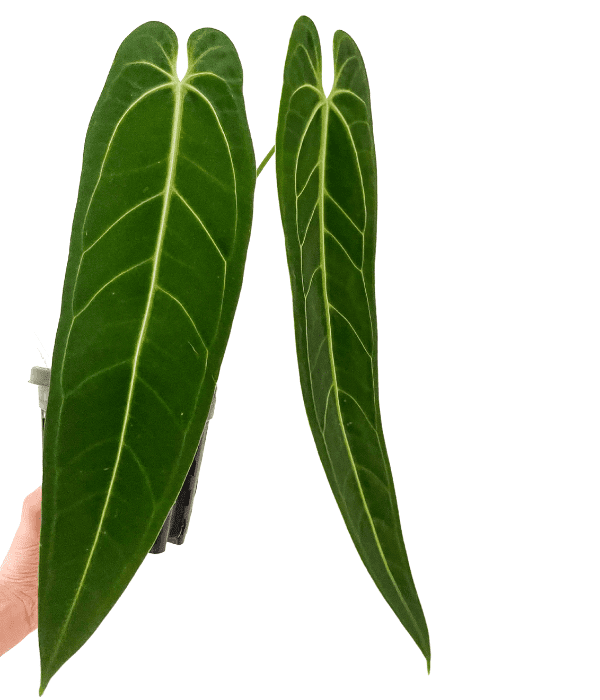
ANTHURIUM WAROCQUEANUM HYBRIDS
Often hybrids are hardier than the mother plants. So if queen anthurium eludes you, try your hand at growing some of its hybrids. This ranking covers the hybrids where Anthurium warocqueanum is the seed parent, but the reverse hybrids are also stunning.
Plant Girl Boss ranks some of the more exciting Anthurium waroqueanum hybrids.
1. ANTHURIUM WAROCQUEANUM X PAPILLILAMINUM
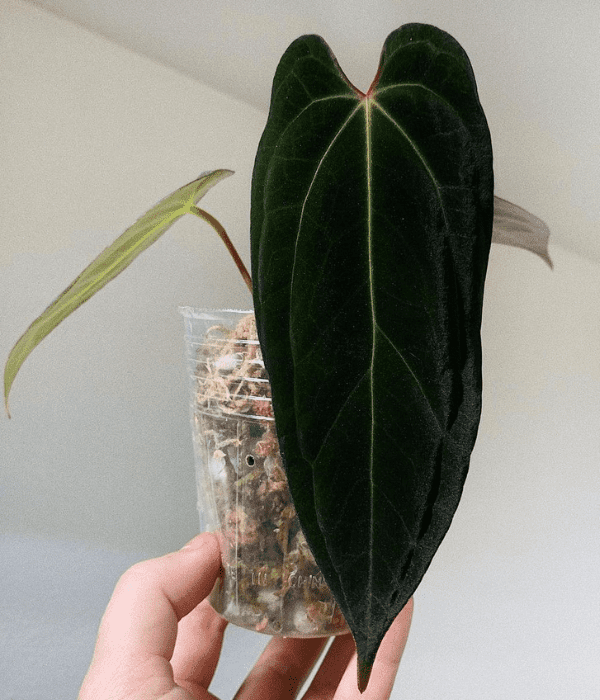
Anthurium warocqueanum x papillilaminum also goes by “Dark Moma” or “Dark Mama,” given its dark green foliage. It gets the characteristic ‘ears’ after Anthurium papillilaminum and the dark velvety leaves after warocq. This unique queen anthurium hybrid tops the ranking.
2. ANTHURIUM WAROCQUEANUM X LUXURIANS

Spot #2 goes to Anthurium warocqueanum and luxurians hybrid. Check out this fantastically textured leaf! You can see the parentage of Anthurium luxurians coming through with the pebbled-like texture. The elongated leaf shape resembles the queen. The anthurium warocqueanum and luxurians hybrid is a showstopper.
3. ANTHURIUM WAROCQUEANUM X RUGULOSUM
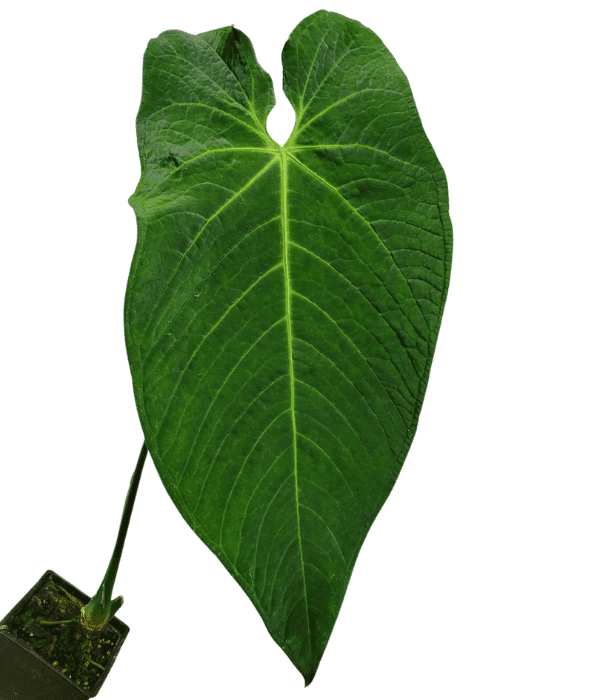
At the #3 spot, we have Anthurium warocqueanum, crossed with Anthurium rugulosum. This beautiful hybrid gets the pebbled leaf texture after rugulosum but the elongated shape after warocqueanum. As the plant matures, the leaves become even more corrugated.
4. ANTHURIUM WAROCQUEANUM X MARMORATUM
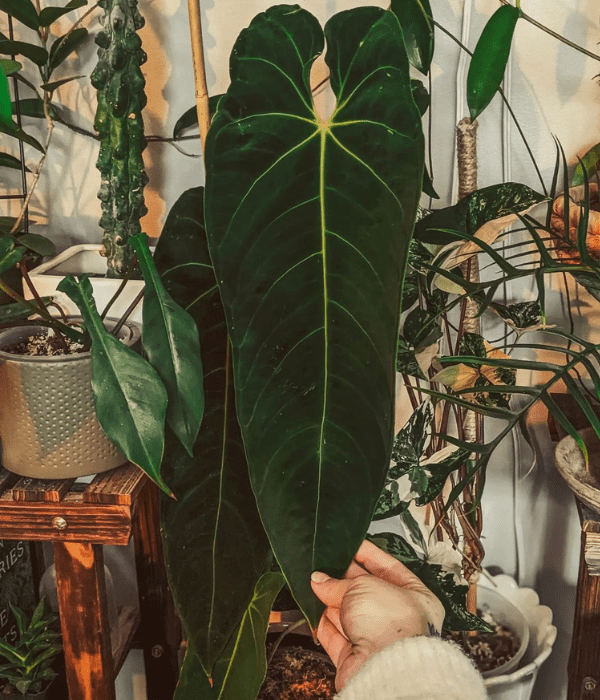
This gorgeous hybrid gets dark green leaves after Anthurium warocqueanum and a wider, slightly ribbed texture after Anthurium marmoratum. This fine specimen belongs to ‘a.hidden.stem‘ and is grown in 60% humidity and 14 inches from grow lights.
5. ANTHURIUM WAROCQUEANUM X WATERBURYANUM

The hybrid of Anthurium warocqueanum and Anthurium waterburyanum is a beauty but, unfortunately, just as temperamental as the queen herself. But the looks are well worth the effort. The leaves are velvety in texture and can grow quite massive.
6. ANTHURIUM WAROCQUEANUM X MAGNIFICUM
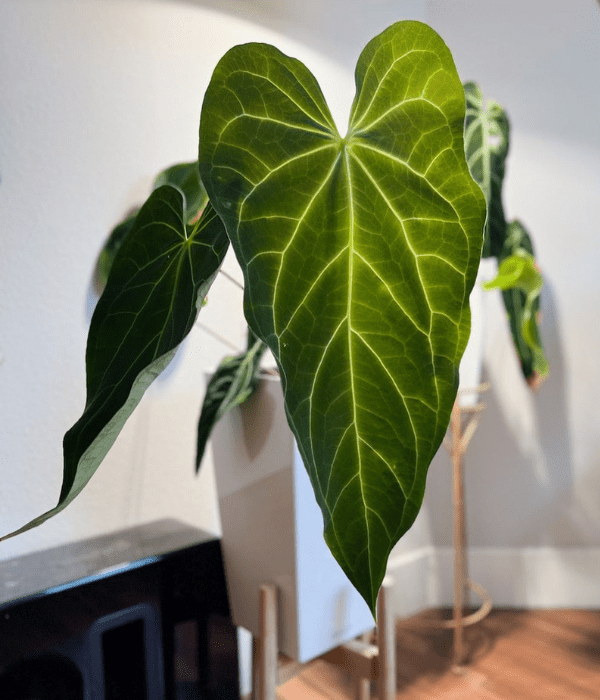
Heart-shaped and elongated, how can you go wrong with Anthurium warocqueanum crossed with Anthurium magnificum? This hybrid takes heart-shaped leaves after the magnificum and the long shape after the queen. It feels like leather to the touch, and it should get on your wish list. It’s definitely on mine!
7. ANTHURIUM WAROCQUEANUM X CRYSTALLINUM
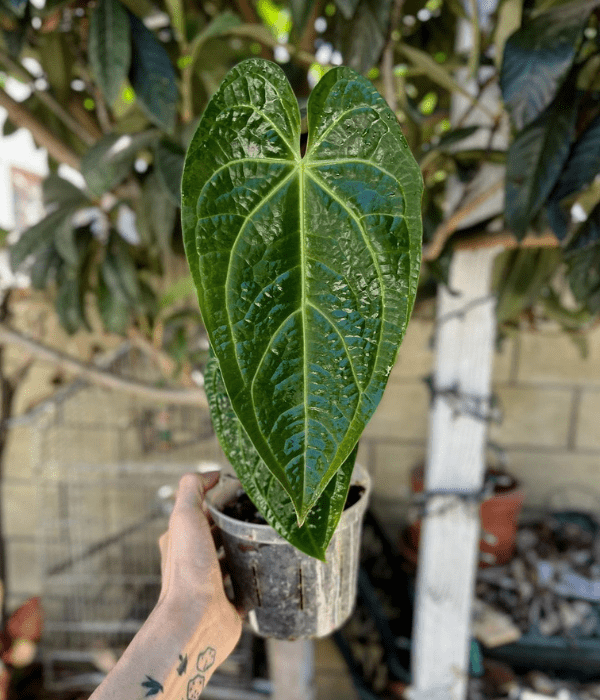
Another hybrid of two-parent species, this variety is characterized by having longer and thinner leaves. The leaves are dark green with visible silver veins. This beauty belongs to ‘phernodendron fernii’, who finds it as easy to grow as Anthurium crystallinum, but the leaves are more sensitive to airflow and humidity like a warocq. It grows in a grow tent at 70-80% humidity.
So there you have it – everything you need to know about Anthurium warocqueanum care and the coolest queen anthurium hybrids. Now that you understand the critical aspects of caring for this queen anthurium, go forth and grow her successfully!
And be sure to check out other blogs on my website for more information on growing amazing anthurium species.

